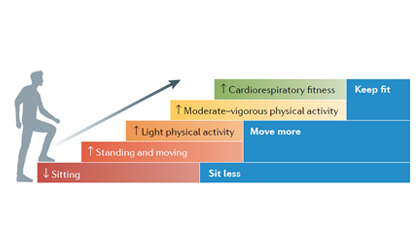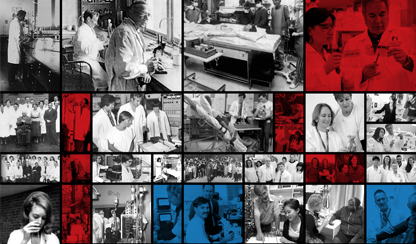20 May 2021
Institute news
 A review led by researchers from the Baker Heart and Diabetes Institute explains new ways GPs, cardiologists and other health practitioners could encourage their patients to sit less and move more to reduce their risk of cardiovascular disease.
A review led by researchers from the Baker Heart and Diabetes Institute explains new ways GPs, cardiologists and other health practitioners could encourage their patients to sit less and move more to reduce their risk of cardiovascular disease.
Such advice could be particularly beneficial for patients with multiple chronic health conditions such as arthritis and angina.
The review, published today in Nature Reviews Cardiology, suggests sitting less and moving more may be a more relevant and achievable approach than more conventional ways of specifying exercise goals and could deliver significant cardiovascular health benefits.
Titled ‘Sit less and move more for cardiovascular health: emerging insights and opportunities’, the comprehensive review provides a perspective that is complementary to the well-understood detrimental impacts of physical inactivity.
Head of Physical Activity Research and lead author, Professor David Dunstan says there is potential for broad cardiovascular health benefits through an integrated approach that involves ‘sitting less and moving more’.
He says sitting occupies a majority of adults’ daily waking hours and has become even more pervasive as a result of the COVID-19 pandemic. But he says sitting less and interrupting prolonged periods of sitting may be a good starting point for many inactive people.
Technological advances and the rise in measurable devices are now delivering new insights into how long people sit for, and Professor Dunstan says the results are cause for concern. In the past, population-based studies using self-reported measures suggested adults typically sat for 5 to 8 hours a day. However, he says device-based estimates from population-based studies of large groups show that the average sitting time is more in the range of 7.7 to 11.5 hours a day.
Professor Dunstan and his colleagues have spent several decades studying sedentary behaviour and physical activity. He says multiple studies, including those conducted at the Baker Institute, have shown that total sedentary time and longer average bouts of time spent sitting impact cardiovascular and diabetes risk. He says studies also show sedentary time impacts vascular function, blood pressure, blood glucose, blood flow to the brain, inflammation, and can even blunt the cardio-protective benefits of exercise.
He says this highlights a fundamental principle that high levels of sitting displace total physical activity time, negating the cardiovascular benefits of skeletal muscle activity. Importantly, it appears that very high levels of daily physical activity (60–75 mins/day) are required to make up for large amounts of time spent sitting.
Professor Dunstan says 30 scientific trials have tested interventions to reduce and break up the long periods of time that many adults spend sitting. The most successful interventions have been those that have include some form of environmental change, such as the introduction of sit-stand workstations which reduced sedentary behaviour by an average of 40 minutes per day.
So with so much research undertaken and more to be done, just what is the current advice?
“Sit less and move more,” says Professor Dunstan. “This may be easier and more effective for people to integrate into their day than making the big transition from being inactive to undertaking a regular exercise program. This can then help them transition to more physical activity in future.”.
Tips for sitting less and moving more
At home
- Get off the couch and walk around the house during commercial breaks.
- Do household chores, such as folding clothes, washing dishes or ironing, while watching television.
- Stand to read your morning newspaper.
- Wash your car by hand rather than using a drive-through car wash.
- Move around the house when checking text and e-mail messages on mobile phone.
At work
- Stand and take a break from your computer every 30min.
- Take breaks in sitting time in long meetings.
- Stand to greet a visitor to your workspace.
- Use the stairs.
- Stand during phone calls.
- Walk to your colleagues’ desk instead of phoning or emailing.
- Drink more water — going to the water cooler and toilet will break up sitting time.
- Move your bin away from your desk so you have to get up to put something in it.
- Use a height-adjustable desk so you can work standing or sitting.
- Have standing or walking meetings.
- Use headsets or the speaker phone during teleconferences so you can stand.
- Eat your lunch away from your desk.
- Stand at the back of the room during presentations.
While traveling
- Leave your car at home and take public transport so you walk to and from stops/stations.
- Walk or cycle at least part of the way to your destination.
- Park your car further away from your destination and walk the rest of the way.
- Plan regular breaks during long car trips.
- On public transport, stand and offer your seat to a person who really needs it.
- Get on/off public transport one stop/station earlier.
Adapted from Australian National Heart Foundation website.





